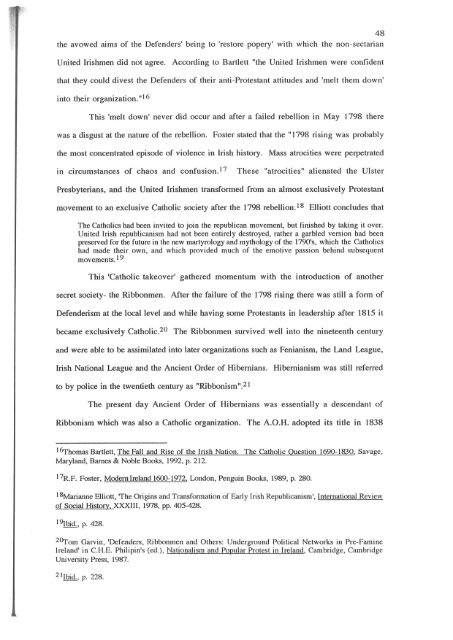TRANSPLANTED IRISH INSTITUTIONS - University of Canterbury
TRANSPLANTED IRISH INSTITUTIONS - University of Canterbury
TRANSPLANTED IRISH INSTITUTIONS - University of Canterbury
You also want an ePaper? Increase the reach of your titles
YUMPU automatically turns print PDFs into web optimized ePapers that Google loves.
48<br />
the avowed aims <strong>of</strong> the Defenders' being to 'restore popery' with which the non-sectarian<br />
United Irishmen did not agree. According to Bartlett "the United Irishmen were confident<br />
that they could divest the Defenders <strong>of</strong> their anti-Protestant attitudes and 'melt them down'<br />
into their organization." 16<br />
This 'melt down' never did occur and after a failed rebellion in May 1798 there<br />
was a disgust at the nature <strong>of</strong> the rebellion. Foster stated that the "1798 rising was probably<br />
the most concentrated episode <strong>of</strong> violence in Irish history. Mass atrocities were perpetrated<br />
in circumstances <strong>of</strong> chaos and confusion. 17<br />
These "atrocities" alienated the Ulster<br />
Presbyterians, and the United Irishmen transfonned from an almost exclusively Protestant<br />
movement to an exclusive Catholic society after the 1798 rebellion. 18 Elliott concludes that<br />
The Catholics had been invited to join the republican movement, but finished by taking it over.<br />
United Irish republicanism had not been entirely destroyed, rather a garbled version had been<br />
preserved for the future in the new martyrology and mythology <strong>of</strong> the 1790's, which the Catholics<br />
had made their own, and which provided much <strong>of</strong> the emotive passion behind subsequent<br />
movements. I 9<br />
This 'Catholic takeover' gatheied momentum with the introduction <strong>of</strong> another<br />
secret society- the Ribbonmen. Mter the failure <strong>of</strong> the 1798 rising there was still a fonn <strong>of</strong><br />
Defenderism at the local level and while having some Protestants in leadership after 1815 it<br />
became exclusively Catholic. 20 The Ribbonmen survived well into the nineteenth century<br />
and were able to be assimilated into later organizations such as Fenianism, the Land League,<br />
Irish National League and the Ancient Order <strong>of</strong> Hibernians. Hibernianism was still referred<br />
to by police in the twentieth century as "Ribbonism".21<br />
The present day Ancient Order <strong>of</strong> Hibernians was essentially a descendant <strong>of</strong><br />
Ribbonism which was also a Catholic organization. The A.O.H. adopted its title in 1838<br />
l~homas Bartlett, The Fall and Rise <strong>of</strong> the Irish Nation. The Catholic Question 1690-1830, Savage,<br />
Maryland, Barnes & Noble Books, 1992, p. 212.<br />
17R.F. Foster, Modem Ireland 1600-1972. London, Penguin Books, 1989, p. 280.<br />
18Marianne Elliott, The Origins and Transformation <strong>of</strong> Early Irish Republicanism', International Review<br />
<strong>of</strong> Social History. XXXIII, 1978, pp. 405-428.<br />
19Jbid., p. 428.<br />
2~om Garvin, 'Defenders, Ribbonmen and Others: Underground Political Networks in Pre-Famine<br />
Ireland' in C.H.E. Philipin's (ed.), Nationalism and Popular Protest in Ireland, Cambridge, Cambridge<br />
<strong>University</strong> Press, 1987.<br />
2 I Ibid., p. 228.
















